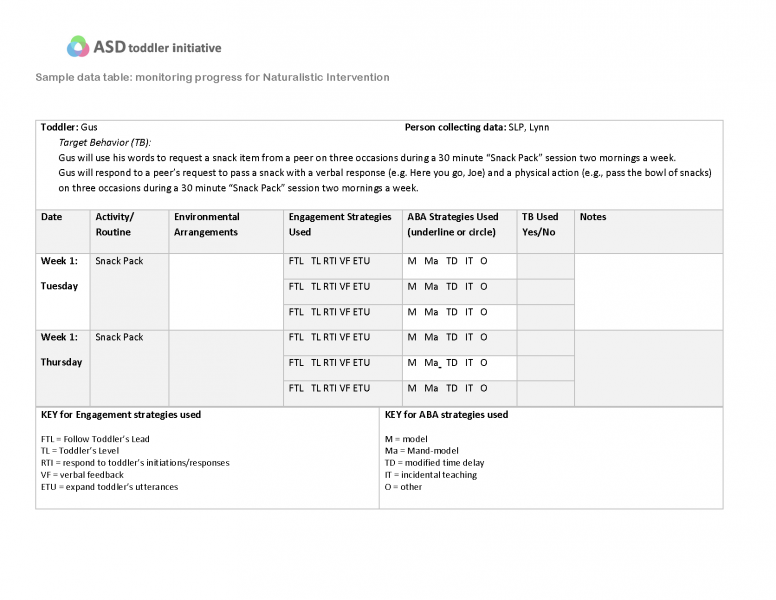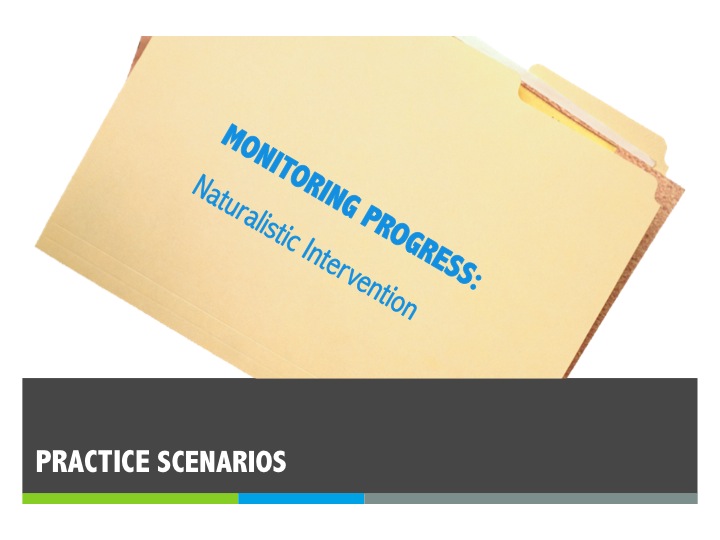Step 3 Monitoring Progress
![]()

During the monitoring step, you will gather data throughout naturalistic interventions to determine the success of the intervention and guide future decision-making.
Step 3.1 Gather and record data
Develop a system to monitor the effectiveness of the intervention that outlines where, when, by whom, and how data are collected.
Monitor the frequency and duration of the interfering behavior and the
replacement behavior
Collect data to monitor the toddler's progress. Data will be collected at planned time periods by taking language samples and/or other data (for example, frequency counts) on strategies that were used to elicit the targeDt behavior. Because naturalistic intervention involves having the conversational partner engaged with the toddler, it can be helpful to either:
- video record the session and collect data off the video at a later point in time or
- have an observer take the data.
However, this may not always be possible, especially in home-based settings where real-time data collection is the most feasible. Then, the interventionist or parent would want to use data collection measures and procedures that are easily accessible during intervention and efficient. This may involve making marks on a piece of masking tape applied to a hand or selecting off tallies on a tablet or smart phone.

Gus will use his words to request a snack item from a peer on three occasions during a 30 minute “Snack Pack” session two mornings a week.
Gus will respond to a peer’s request to pass a snack with a verbal response (e.g. Here you go, Joe) and a physical action (e.g., pass the bowl of snacks) on three occasions during a 30 minute “Snack Pack” session two mornings a week.
Example of data collection procedures that may be used real time in home and center-based settings:
-
Wrapping paper or masking tape around one’s wrist on which data can be tallied.
-
Placing data collection sheets near the location of the activity.
-
Gathering data from multiple toddlers in a center-based group on address labels that can later be peeled off and put on individual toddlers’ data sheets.
-
Using technology such as tablet or smart phone to click off data.
Step 3.2 Analyze data to determine next steps
Compare intervention data and baseline data to determine the effectiveness of the
intervention
Review and analyze the data on a periodic and agreed upon basis. This helps to determine what the data indicates about progress toward meeting a toddler’s target behavior. Use the data to assess whether the naturalistic intervention is achieving the desired results or if it may need to be modified. Through data analysis, you may discover that the target behavior has been met and that the goal needs to be ramped up to a more complex response.
Summarize the data to make decistions about future planning
For a naturalistic intervention, there are important decision-making points between engagement and use of ABA strategies when the early intervention team has to decide if the engagement strategies are sufficient for eliciting and reinforcing the target behavior. Careful consideration of the data helps the intervention team identify which ABA strategy may work the best to elicit a target behavior. Also, data will be useful in determining if other environmental arrangements are needed or if additional training may be required by members of the intervention team.
Together with the team, you may decide that additional data is needed to gain a better understanding of how to modify a naturalistic intervention.
Practice Scenario: Monitoring Naturalistic Intervention
The practice scenario will open in a new browser tab/window.
When you have finished reviewing,
return to the module and take the Knowledge Check.
Knowledge Check

Question:
Which of these elements provide useful data for analyzing the effectiveness of a naturalistic intervention?
A. quantitative data (frequency and duration)
B. observational notes
C. environmental arrangements
D. specific routine or activity
Question:
What are some reasons why is it important to identify the activity or routine and the environmental arrangement when collecting data on a naturalistic intervention?


